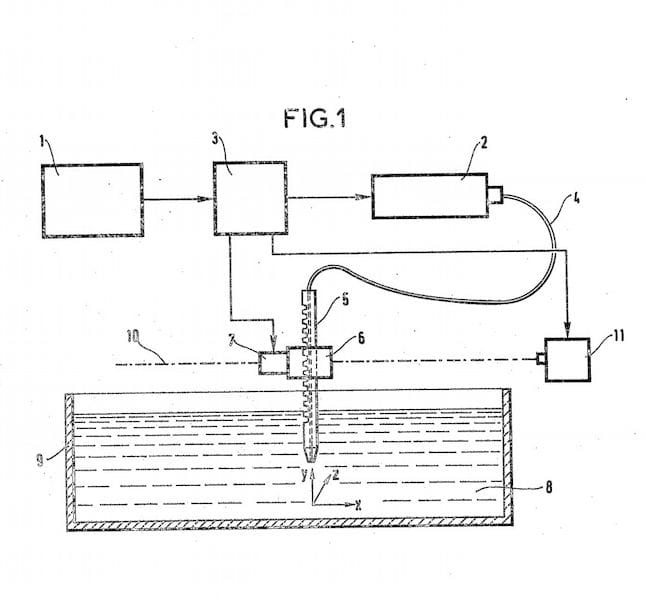![Diagram for a form of SLA 3D printing from a 1984 French patent [Source: INPI]](https://fabbaloo.com/wp-content/uploads/2020/05/image-asset_img_5eb0a517673ef.jpg)
When was the first 3D printer invented again?
The common understanding is that American Charles Hull invented SLA-style 3D printing in 1984 and Scott Crump invented plastic extrusion 3D printing in 1987. But earlier this week we published a story suggesting that an earlier patent for another form of 3D printing occurred.
In the story we reported that American Bill Masters patented an unusual process involving “shooting” particles to build up a 3D model in July 1984, weeks before Hull filed his patent. Unfortunately for Masters, Hull’s approach was more practical and resulted in the formation of 3D Systems, one of the giants in 3D printing today.
Meanwhile, Masters’ approach was attempted but never caught on and the company doing so faded from existence, as well as the public’s knowledge of the earlier patent.
Now evidence pointed out by Fabbaloo reader Baptiste Guérin suggests that there was an even earlier patent for a 3D printing process. Guérin explains:
”This is totally false, contrary to an idea received the real inventors of 3D printing are not American but French: Alain Le Méhauté, Olivier de Witte and Jean Claude André. Here is the filing of the patent of July 16, 1984:”
We reviewed this material and found several interesting things. Here is the key claim in the French patent (en Français):
“Dispositif pour rėaliser un modéle de pièce industrielle. Le dispositif comporte un système de mémoires 1 contenant des informations sur la forme de la pièce, un génèrateur laser 2 relié au système de mémoires 1 par un circuit de traitement . Une fibre optique 4 couplée à la sortie du génèrateur laser 2, et des moyens 6, 7, 11 pour déplacer l’extrémité libre de la fibre 4 dans une cuve 9 replie d’un liquide monomére polymérisable 8. Ces moyens étant commandés par les signaux de sortie de circuit de traitement 3. Application à la réalisation d’un modèle de bielle.”
If your Français is not up to spec, then you can review this Google Translation:
“Device for making a model of an industrial part. The device comprises a memory system 1 containing information on the shape of the part, a laser generator 2 connected to the memory system 1 by a processing circuit. An optical fiber 4 coupled to the output of the laser generator 2, and means 6, 7, 11 for moving the free end of the fiber 4 in a tank 9 folded of a polymerizable liquid monomer 8. These means being controlled by the output signals of processing circuit 3. Application to the realization of a connecting rod model.”
If that doesn’t sound like an SLA 3D printer, I don’t know what would.
The description of the device, and associated diagrams, appears to show a laser being used to solidify a liquid photopolymer. This is precisely a SLA 3D printing process.
The filing date of this French patent is 16 July 1984, some 17 days before Masters’ patent and 54 days before Hull’s.
It is very curious to me why three people came up with more or less the same idea within days of each other in 1984. It is likely a case of the component technologies becoming available and some bright minds putting the pieces together to make a new solution.
![Yes, the 1984 French patent for a 3D printing device even includes a “Figure 4” [Source: INPI]](https://fabbaloo.com/wp-content/uploads/2020/05/image-asset_img_5eb0a517c81f5.jpg)
Obviously, the French patent did not manifest into any commercial solution that exists today.
So who invented 3D printing? One of these folks? Perhaps — but who knows, maybe there is another patent buried somewhere else with an even earlier claim.
What matters more is that evidently civilization reached a point in 1984 where this technology was inevitable, and from then on it has simply been a matter of commercial competition and increasingly powerful research being transformed into products.
To me the biggest issue is the same now as it was then: convincing people to use 3D printing to solve their making challenges. It’s only now becoming easier to do so, as more companies are jumping on the 3D wagon due to intense competition and innovative uses.
Imagine how difficult it must have been in 1984 to convince anyone that this technology is useful. But I’m very glad at least some of them were able to do so.
Via INPI











A key patent assigned to 3D Systems expires in 2022. What will this mean for 3D Systems and everyone else? We have some thoughts.